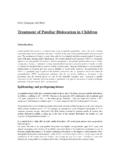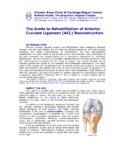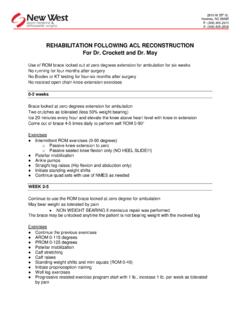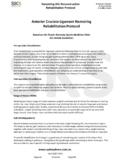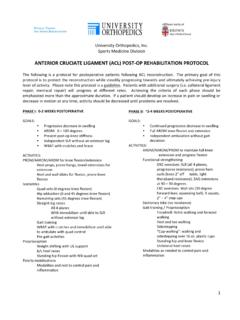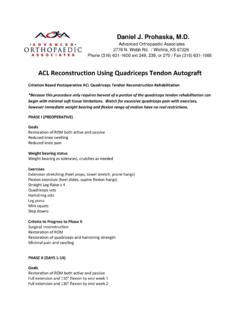Transcription of Rehabilitation of the Knee After Medial Patellofemoral ...
1 R e h a b i l i t a t i o n of th e K n e e A f t e r Me d i a l Patellofemoral ligament reconstruction Donald C. Fithian, MDa,b,c,*, Christopher M. Powers, PhD, PT. d,e , Najeeb Khan, MDb,c KEYWORDS. Medial Patellofemoral ligament reconstruction Rehabilitation Exercise Lower limb Rehabilitation of the extensor mechanism After patellar stabilization surgery should be based on a sound understanding of lower limb mechanics, anatomy, mechanics of the injured or repaired extensor mechanism, and a careful evaluation of the patient. Abnormal anatomic features and control deficits can, and often do, affect function of the Patellofemoral joint. Current evidence suggests that Patellofemoral rehabilita- tion should address dynamic lower extremity function, such as abnormal lower extremity motions stemming from impairments proximally (ie, hip) or distally (ie, foot), because such motions can influence the dynamic quadriceps angle (Q-angle).
2 (Fig. 1).1 In addition, many patients with episodic patellar instability have preexisting anatomic deficiencies that may affect Joint surface injury and degen- erative articular lesions also may call for variations to the Rehabilitation protocol. The purpose of this article is to provide the reader with an understanding of the current state of lower limb Rehabilitation for patients who have undergone Medial patellofe- moral ligament (MPFL) reconstruction . Conflict of Interest: Dr Powers acknowledges a financial interest in the SERF Strap that was mentioned in this paper. a Southern California Permanente Medical Group, San Diego, CA, USA. b Department of Orthopedic Surgery, Kaiser Permanente, 250 Travelodge Drive, El Cajon, CA. 92020, USA.
3 C San Diego knee and Sports Medicine Fellowship, San Diego, CA, USA. d Musculoskeletal Biomechanics Research Laboratory, University of Southern California, Los Angeles, CA, USA. e Program in Biokinesiology, Division of Biokinesiology & Physical Therapy, University of Southern California, 1540 East Alcazar Street, CHP 155, Los Angeles, CA 90089-9006, USA. * Corresponding author. Department of Orthopedic Surgery, Kaiser Permanente, 250. Travelodge Drive, El Cajon, CA 92020. E-mail address: ( Fithian). Clin Sports Med 29 (2010) 283 290. 0278-5919/10/$ see front matter 2010 Elsevier Inc. All rights reserved. 284 Fithian et al Fig. 1. A diagrammatic representation of the various potential contributions of limb mala- lignment and malrotation to increase Q-angle: (1) hip adduction, (2) femoral internal rota- tion, (3) genu valgum, (4) tibial external rotation, and (5) foot pronation.
4 (From Powers CM. The influence of altered lower-extremity kinematics on Patellofemoral joint dysfunction: a theoretical perspective. J Orthop Sports Phys Ther 2003;33(11):644; with permission.). PAIN AND SWELLING. MPFL reconstruction is a painful procedure. Severe postoperative pain can inter- fere with active muscle control. Pain can also impede progress with range of motion (ROM). Operating at or near the Medial epicondyle of the knee often is associated with postoperative stiffness because of the higher degrees of motion of the injured soft tissues relative to the femur during knee flexion and extension. It is important to address this tendency aggressively in the early postoperative phase to avoid stiffness. Once the motion has been established, Medial pain and knee stiffness caused by scarring at the femoral attachment of the graft are rare problems.
5 Swelling, either as free intra-articular fluid (effusion) or as soft tissue edema, also can interfere with joint motion. In addition, effusion inhibits quadriceps function3 and may be harmful to intra-articular structures, such as articular cartilage. Both pain and swelling can be addressed in various ways. Strict elevation of the limb and limited activity in the first 1 to 2 days postoperation allow the acute inflam- matory phase to pass without further perturbation by overaggressive therapy. During that time, cold therapy may be helpful, whether in the form of ice packs or commer- cially available cold therapy units. The use of cold therapy to reduce local pain, inflammation, and swelling is a traditional mainstay of treatment After injury.
6 Medial Patellofemoral ligament reconstruction 285. ROM. Prolonged joint immobilization results in the loss of ground substance and dehydration of the extracellular ,5 These changes reduce the distance between fibers within the matrix, causing friction and adhesion that reduce suppleness in periarticular liga- ments and cartilage. In contrast, mobilization of an injured joint is associated with enhanced collagen synthesis and more optimal fiber realignment within the tissues, reversing the processes seen with immobilization. It is not always possible to move joints immediately After surgery, but early motion is clearly Experience has shown that immediate, controlled ROM is not detri- mental to fixation or graft development in well-positioned and securely fixed ACL.
7 Grafts. Furthermore, early motion seems to be beneficial to the limb as a whole by reducing pain, promoting healthy development of cartilage and periarticular tissues, and preventing scar formation and capsular Therefore 1 goal of MPFL reconstruction is to use a competent graft, place it so that it will not be harmed by physiologic motion, and secure it well enough to withstand the loads associated with normal joint motion. After MPFL reconstruction , loss of full passive extension is rarely seen. However, it can be difficult to regain full flexion. In addition, failure to achieve full active extension (residual extensor lag) has been reported at short and long-term The reasons for motion difficulties After MPFL reconstruction seem to be related to the dissection and MPFL graft location.
8 Cyclops lesions, such as those that can physically block knee extension After ACL reconstruction , have not been reported After MPFL. reconstruction . But capsular and/or infrapatellar fat pad contracture, quadriceps inhi- bition, and poorly positioned grafts can lead to the complications noted earlier. An early goal of Rehabilitation After MPFL reconstruction is to reestablish full knee extension. Unlike ACL reconstruction , return of passive knee extension does not guar- antee full active extension. For that to occur, attention must focus on quadriceps strengthening (see later discussion for details). Pain and swelling can be mitigated with electrical stimulation, cold therapy, and compression wraps. Passive patellar glides should be instituted as soon as tolerated, to reestablish normal passive patellar mobility within the trochlear groove in all directions (superiorly, inferiorly, medially, and laterally).
9 Many patients have considerable apprehension because of their prior expe- rience with patellar hypermobility, and mobilization can improve confidence in their newly acquired patella stability. Return of passive flexion can be difficult for several reasons. If the graft is not posi- tioned properly it may tighten in flexion and tether the joint. Injury around the Medial epicondyle, whether traumatic or surgical, is also associated with persistent joint stiff- ness if early attention is not given to full knee flexion in the Rehabilitation program. The goal is to exceed 90 flexion within 6 weeks postoperatively. If that goal is achieved, then in the authors' experience limited knee flexion will not be a problem. On the other hand, delay in achieving greater than 90 of knee flexion may allow scar tissue prolif- eration and formation of adhesions around the graft and within the Medial knee soft tissues.
10 Manipulation may be required to regain full knee motion if flexion past 90 . is not accomplished by week 6. QUADRICEPS STRENGTHENING. Surgery of the extensor mechanism is particularly prone to cause quadriceps inhibition and dysfunction, and every effort should be made to regain quadriceps control, strength, and endurance. If the reconstruction has been performed properly, then controlled quadriceps contractions pose no threat to the graft. Quadriceps setting 286 Fithian et al exercises should be started immediately After the surgery to keep the patellar tendon and infrapatellar fat pad stretched to their full length and to restore neuromuscular control. Resisted quadriceps and hamstring strengthening should be progressively used as the initial pain subsides.
